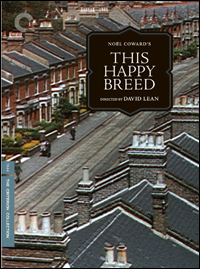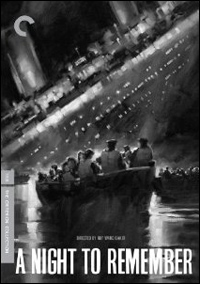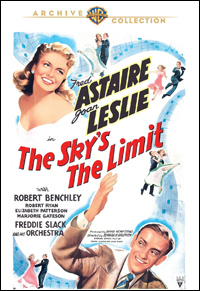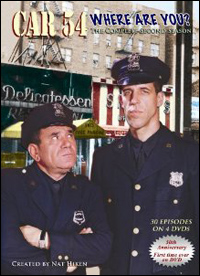
*
If ever you wonder why high quality films are frequently licensed by their owners to the Criterion Collection — and not just old, black & white classics — you need look no further than the new 4-disc set, David Lean Directs Noel Coward [Criterion]. These are not significant studio money-earners, true; one of the titles is a beloved and iconic classic, another might be termed a minor classic of sorts, and the others are respected films that have been relatively out of view.
What Criterion has done and repeatedly does — besides the not-insubstantial act of simply making these titles readily available — is restore these films beyond measure, both picture and sound. Which in the case of a stunning film like "Brief Encounter" is a true gift. Criterion also crams their releases with bonus features; not the sort that you can find here or there, but things which people who love the film(s) in question will actually be eager to watch. They add a booklet of pertinent essays, too. Criterion releases are, typically, somewhat more expensive than the plain variety reissue (with or without mastering, with or without bonuses). But the overall packages present true explorations of the film, not just simply a copy of the movie.
Lean — he of the sweeping "Bridge on the River Kwai," "Lawrence of Arabia," and "Doctor Zhivago" — does not necessarily seem an obvious match for the enfant terrible of the Haymarket. But the pairing made perfect sense at the time. Lean was already an expert editor, with credits including the film adaptations of Shaw's Pygmalion and Major Barbara. When Coward was signed to direct his first film in 1942, he enlisted Lean to co-direct. "In Which We Serve," the earliest title in this collection, was a full-throttle patriotic paean to the British war effort, with Coward starring, writing, producing, composing, and who knows what else. And, yes, co-directing with Lean.
Coward based his script on a real-life event, the 1941 sinking of the HMS Kelly during the Battle of Crete. Coward's friend Lord Louis Mountbatten was in command; Noel plays a fictionalized version of his friend, here called Captain Kinross. The film really does do its job, and does it well. The cast includes John Mills, Bernard Miles, Celia Johnson, Kay Walsh (the then-Mrs. Lean), and Michael Wilding (the future Mr. Elizabeth Taylor).
 |
||
| Cover art for "This Happy Breed" |
During the making of these first two films, Coward was raking in the pounds and dollars from his longest-running comedy success, Blithe Spirit. The 1941 play was simultaneously produced in London (where it opened at the Piccadilly in July, for 1,997 performances) and New York (at the Morosco in November, for 657). Coward appeared in neither, presumably eschewing London so that he could recreate his direction in New York. He did, though, play the role in the U.K. tour which opened just after the 1942 release of "In Which We Serve." Blithe Spirit brought enormous cheer to war-weary audiences, with the Coward stand-in originated by Cecil Parker in London and Clifton Webb in New York. For the film, Rex Harrison took the lead, supported by Kay Hammond (Elvira) and Margaret Rutherford (Madame Arcati) from the West End company, along with Constance Cummings as Ruth. David Lean's film of "Blithe Spirit" — produced by Coward — remains a delightfully whimsical joy.
The prize of the set, naturally enough, is "Brief Encounter." Here we have Celia Johnson (once again) and Trevor Howard in that railway station refreshment room, as Rachmaninoff's Second Piano Concerto swells on the soundtrack. "Brief Encounter" was derived from Still Life, one of the short plays that encompassed Coward's 1936 tour-de-force Tonight at 8:30. (These were ten one-acts — nine in New York — which were performed by Coward and co-star Gertrude Lawrence over the course of three evenings; given Coward's numerous professional activities, the runs were limited.) Still Life was significantly transformed by Lean to become "Brief Encounter"; this is a Coward/Lean collaboration, and an altogether magical one. Which is to say that Lean — before he approached that series of sweeping classics typified by "Lawrence of Arabia" — was indeed well suited to Coward.
The high-definition digital transfers in this 4-disc set — released simultaneously with the current "Noel Coward in New York" Festival — are crammed with special features. New interviews with Coward scholar Barry Day; audio commentary on "Brief Encounter" by film historian Bruce Eder; "David Lean: A Self Portrait," a television documentary from 1971; a 1992 episode on Coward from "The Southbank Show": an audio conversation between Coward and Richard Attenborough (who made his film debut in "In Which We Serve"); a 2010 interview with Ronald Neame, cinematographer of the first three titles and co-producer/co-scenarist of "Brief Encounter"; short documentaries on the making of "In Which We Serve" and "Brief Encounter"; and more. Plus a booklet filled with essays and keenly-selected photographs.
Visit PlaybillStore.com to check out theatre-related DVDs for sale.
 |
||
| Cover art for "A Night to Remember" |
 |
||
| Cover art for "Vanya on 42nd Street" |
What seems to be a modern-dress rehearsal of Vanya is really something more; the actors rehearsing Vanya are soon transported, through the magic of Mr. Gregory and their collective acting skills, into the characters themselves. The performances are highly watchable, led by the Vanya of Wallace Shawn, the Astrov of Larry Pine, the Yelena of Julianne Moore, and the Serebryakov of George Gaynes. Also on hand, as the nanny Marina, is 89-year old Phoebe Brand, a Group Theatre alumni who was blacklisted along with husband Morris Carnovsky.
The other star of the film, it might be said, is the New Amsterdam Theatre. Or perhaps we should call it the Old Amsterdam, in the state it was back before Disney and their Lion King spruced it up and dusted it off (and then some). Back in 1994, the house is severely distressed and nearly in ruins — although presumably in better shape for filming than the Victory. The action is played in what had been the front section of the orchestra, with seats removed; the stage at that point was unstable. The all-but-haunted house, with that grapes-and-vine decorative motif, makes an effective stand-in for Serebryakov's country estate. (Take-out cardboard coffee cups — with the familiar blue & white Greek design — are scattered along the walls and ledges, somehow enhancing the setting.)
You really do get a sense of Chekhov's 19th-century characters living and breathing, just off Times Square. The film opens, for those interested in such things, with a 42nd Street street scene — and it is authentic, for sure. That's what it looked like, not so long ago. The recessed hot dog stand at which Shawn is discovered, munching a knish, was part of the outdoor entrance lobby of the old Selwyn Theatre office building. The outer lobby is gone, but the Selwyn survives as the Roundabout's American Airlines. Visit PlaybillStore.com to check out theatre-related DVDs for sale.
 |
||
| Cover art for "The Sky's the Limit" |
No matter because of one intriguing sequence. Which leads us to discussion of the songs. This was not a musical, not in the Astaire sense; merely three songs, by the extra-special team of Harold Arlen and Johnny Mercer (who had established their joint pedigree with the 1941 "Blues in the Night"). The big ballad in "The Sky's the Limit" is an especially good one, "My Shining Hour." There is also an all-but-unknown comedy turn, "A Lot in Common with You."
But the showpiece comes late in the story, with Fred in his cups after a night of drinking with Robert Benchley. Benchley leaves Fred alone with bartender Joe, who's getting kinda anxious to close, and out pours the second great Arlen-Mercer blues classic, "One for My Baby (and One More for the Road)." Why Fred is so upset, I can't tell you; not exactly derived from the story, or what there is of it. But he is. The camera follows him to a second saloon and a third, still singin' away. Finally, Fred jumps up on the bar and does an angry, drunken dance; the choreographer-within-him no doubt wondered what would happen if he put a lot of glasses up there and just started kicking them to smithereens, rhythmically. And the big bar mirror, too. How long for them to restore the set after each take, I wonder?
So here's Fred Astaire unlike you've ever seen him. For Gene Kelly fans, Warner Archive has simultaneously released a similarly obscure companion piece: the 1947 MGM comedy "Living in a Big Way." Gene dances with a dog in this one — "Fido and Me" is the song — but I don't think I'll bite.
*
 |
||
| Cover art for "Car 54, Where Are You?: The Complete Second Season" |
(Steven Suskin is author of the recently released Updated and Expanded Fourth Edition of "Show Tunes" as well as "The Sound of Broadway Music: A Book of Orchestrators and Orchestrations," "Second Act Trouble" and the "Opening Night on Broadway" books. He also pens Playbill.com's Book Shelf and On the Record columns. He can be reached at [email protected].)
*
Visit PlaybillStore.com to check out theatre-related DVDs for sale.









